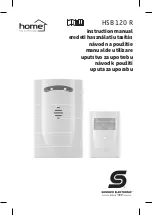
44
FCC Part 68 Notice (continued)
Alarm dialing equipment must be able to seize the telephone line and place a call in an emergency situation. It must be able to
do this even if other equipment (telephone(s), answering system, computer modem, etc.) already has the telephone line in use.
To do so, alarm dialing equipment must be connected to a properly installed RJ31X that is electrically in series with and ahead
of all other equipment attached to the same telephone line. Proper installation is depicted in the fi gure on the previous page. If
you have any questions concerning these instructions, you should consult your telephone company or a qualifi ed installer about
installing the RJ31X jack and alarm dialing equipment for you.
Alarm Installation Notes to Installer
For products equipped with an RJ31X jack the line seize feature shall be verifi ed. Be certain the local telephone and incoming line
connections are not reversed. These lines are not reversed if the alarm dialer can communicate with the central station.
New Services Notes to User
The installation and/or monitoring company shall be notifi ed if new telephone service, e.g. DSL, is installed.
Industry Canada Notice (for Canadian users)
The Industry Canada (IC) label identifi es certifi ed equipment. This certifi cation means that the equipment meets certain
telecommunications network protective, operational and safety requirements. The IC does not guarantee the equipment will
operate to the user’s satisfaction.
Before installing this equipment, users should ensure that it is permissible to be connected to the facilities of the local
telecommunications company. The equipment must also be installed using an acceptable method of connection. In some cases,
the company’s inside wiring associated with a single line individual service may be extended by means of a certifi ed connector
assembly (telephone extension cord). The customer should be aware that compliance with the above conditions may not prevent
degradation of service in some situations.
Repairs to certifi ed equipment should be made by an authorized Canadian maintenance facility designated by the supplier. Any
repairs or alterations made by the user to this equipment, or equipment malfunctions, may give the telecommunications company
cause to request the user to disconnect the equipment.
Users should ensure for their own protection that the electrical ground connections of the power utility, telephone lines and
internal metallic water pipe system, if present, are connected together. This precaution may be particularly important in rural
areas.
CAUTION:
Users should not attempt to make such connections themselves, but should contact the appropriate electric inspection
authority, or electrician, as appropriate.
The Load Number (LN) assigned to each terminal device denotes the percentage of the total load to be connected to a telephone
loop which is used by the device to prevent overloading. The termination on a loop may consist of any combination of devices
subject only to the requirement that the total of the Load Number of all the devices does not exceed 100.
The Ringer Equivalence Number (REN) is used to determine the quantity of devices that may be connected to the telephone line.
Too many devices may result in some devices not ringing in response to an incoming call. In most, but not all areas, the sum
of the REN’s should not exceed fi ve (5.0). To be certain of the number of devices that may be connected to the line, contact the
telecommunications company to determine the maximum REN for the calling area.
Refer to the equipment label for the unit’s load number or REN number
Regulatory Information







































